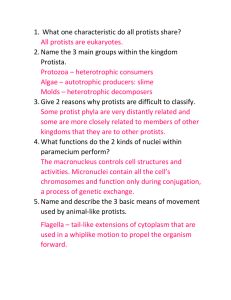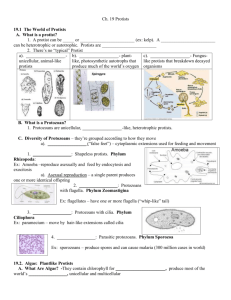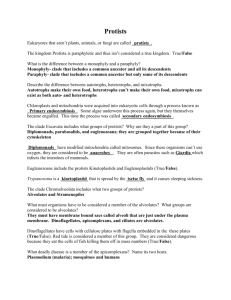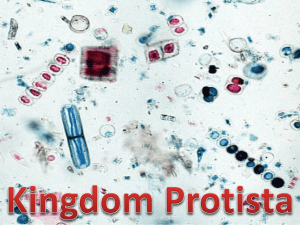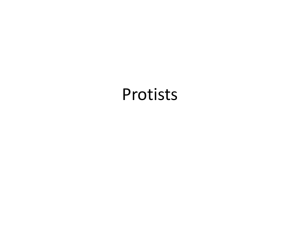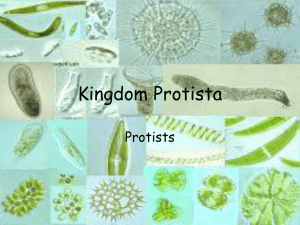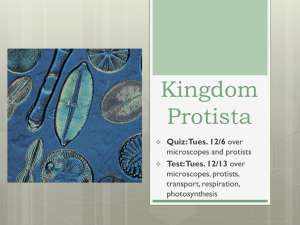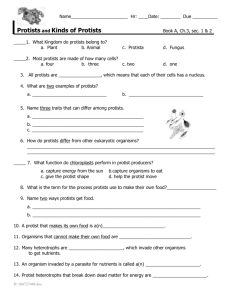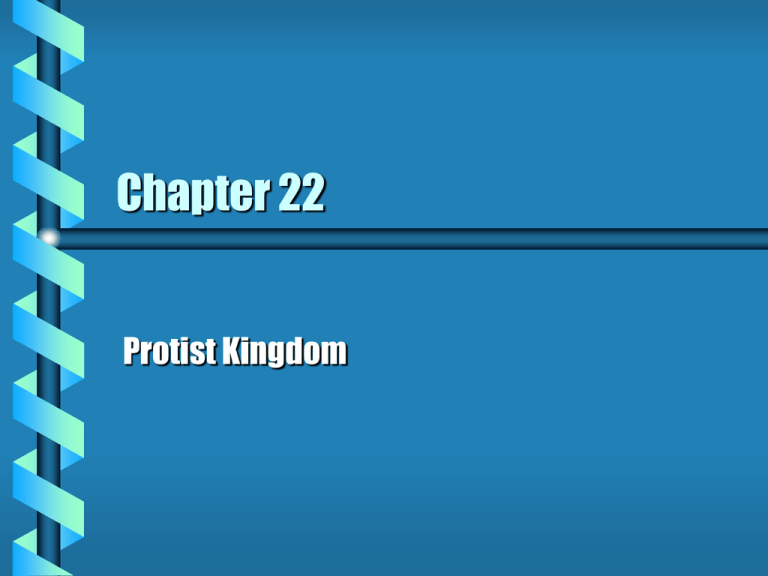
Chapter 22
Protist Kingdom
I. Characteristics of Protists
Eukaryotes
unicellular
3 Main groups of protists;
• Protozoans
• algae
• fungus-like
3 Groups of Protists:
1. Protozoans
Animal like protists
Protozoans - Animal like
Grouped
•
•
•
•
by movement
pseudopods
cilia
flagella
parastites - no movement
Protozoan Characteristics
No cell wall
Free-living or
parasitic
Consumers
Habitat – aquatic
(ponds,lakes, oceans)
Examples: amoeba,
paramecium,
dinoflagellates
Example 1: Protozoans - amoebas
Amoebas
• shapeless, aquatic
Pseudopods in Amoebas
How Amoebas Eat ?
• feeding structures– food vacuole
– digestive enzymes
– diffusion
Getting Rid of Waste
Contracting vacole –
collect excess water from
inside the cell and gets rid of it.
Reproduction of Amoeba
• asexual reproduction
– Binary fission
Dysentery (an illness)
Inflammation of the
large intestine
Diarreha and vomiting
Caused by an amoeba
2. Example 2: Protozoans: Ciliates
Locomotion - Cilia
1. Paracmecium fresh water ciliate
•
How do Paramecium eat?
Feed on bacteria
• Food enters oral
groove,
• moves to the food
vacoule,
• anal pore
Paramecium Reproduction
Asexual- create identical organisms
Conjucation - sexual reproduction
• exchange of genetic information
• Not identical - adds diversity
3. Example 3: Protozoans Flagellates
Locomotion - use
flagella
Exmaples:
2. Trypanosoma - causes
African Sleeping
Sickness
• spread by tsetse fly
4. Example 4: Protozoan sporozoans
Locomotion - parasitic
reproduction
• spores
Plasmodium - Causes
Malaria
• Spread by mosquito
• Quinine – drug used to
treat malaria
Vorticella
Attaches to and spins
its cilia to create a
vortex (water
movement”
Stentor
2. Euglena – 2nd group in protist
Both plant-like and
animal-like
Euglenoids
- contain chlorophyll
- move by flagella
- Euglena (unique)-
• eyespot,
• chloroplast,
• flagellum
Algae
Plant like protists
B. Algae - plant-like
Photosynthetic
Multi-cellular and unicellular
Classified by pigments (Types of Algae)
•
•
•
•
red
brown
Green+
Examples; Volvox, diatoms, spirogyra
1. Diatoms
- float in water
- photosynthesis
- unicellular
- silica shells
Commercial value: Insulating materials,
Abrasives , Ceramics, Filtering
2. Dinoflagellates
- move by two flagella
- autotrophs
- green glow and red tides
3. Green Algae (Lab 37)
Most freshwater
Food Source – called
Plankton
Some are:
• Free-living
• Colony
• filament
Free-Floating -
- Filament type – exist as a thread
Colony -
Label and Draw
Ulothrix
Zygnema
Spirogyra
Hydrodictyon
Peridinium
chlamydomonas
Red and Brown Algae
All multicellular
Marine
Kelp – a form of brown
algae
Red algae – used in
food.
Fungus Protists
Slime Molds
- plasmodium- visible slime mass
- moves
- no cell membrane
- many nuclei
- grow on damp organic matter - decompose
- form a stalk, release spores
- Reproduce - asexual reproduction, making
spores
Fungus Like Protists
Classified by how they reproduce
• slime molds
• mold and mildew - disease causing
Mildew and Water Molds
- fuzzy growths
- found on bathroom tiles
- live off of dead material
- potato famine- 2 million people died in
Ireland
- caused immigration to the United States
Protist Diversity
Examples
Groups of :
Protozoans
Algae
Funguslike
Characteristic Motility
s
habitat
Origins and Importance of
Protists
Green algae
Importance of :
• green algae - oxygen source
• food source – plankton
– zooplankton
– phytoplankton

